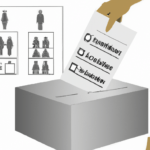An electoral system is a method used to determine the outcome of elections in a democratic society. It is a framework that establishes the rules and procedures for electing representatives and leaders. Electoral systems vary across different countries and can have a significant impact on the distribution of political power. They shape the ways in which votes are cast, counted, and translated into seats or positions of power. From simple plurality systems to proportional representation systems, each electoral system has its advantages and disadvantages, affecting voter representation, political party dynamics, and the overall fairness and legitimacy of the electoral process.
Electoral systems are mechanisms used to determine the outcome of elections. They provide a structured process for citizens to select their representatives and leaders, ensuring fair and democratic governance.
One common type of electoral system is the plurality or “first-past-the-post” system, where the candidate or party with the most votes wins. This system is straightforward, but it can lead to a lack of proportional representation, as candidates who receive a minority of votes in some constituencies are not represented.
Alternatively, proportional representation (PR) systems aim to allocate seats in proportion to the overall votes received by each party. This allows for a more accurate reflection of citizens’ preferences and ensures a fairer distribution of power. List PR and Single Transferable Vote (STV) are two popular types of PR systems used in different countries.
In List PR systems, voters cast their ballot for a party rather than individual candidates, and seats are allocated based on the proportion of votes received by each party. This method encourages multi-party representation and aims to prevent wasted votes. STV, on the other hand, allows voters to rank candidates in order of preference and redistributes votes during the counting process until candidates reach a required threshold.
Mixed-member proportional (MMP) systems combine elements of both plurality and PR. Voters cast two votes: one for a local representative and another for a political party. The allocation of seats combines both the local candidates elected by plurality and the additional seats allocated based on overall party votes, ensuring a balance between local representation and proportionality.
Other electoral systems include the two-round system, alternative vote, and majority systems. These systems often aim to secure a majority winner, which is particularly crucial in presidential elections.
Overall, the choice of electoral system can have a significant impact on the representation and legitimacy of elected officials. It is crucial for democracies to continuously evaluate and consider the strengths and weaknesses of different electoral systems to ensure the best possible outcomes for their citizens.
Types of electoral systems
Types of electoral systems refer to the different methods by which votes are cast and candidates are elected in a democratic process. These systems vary around the world, and each has its own advantages and disadvantages. Here are some of the most common types of electoral systems:
1. First-Past-The-Post (FPTP) System: In this system, the candidate who receives the highest number of votes wins, even if they do not secure an absolute majority. This system is used in countries like the United Kingdom and the United States. Critics argue that this system can sometimes lead to a lack of proportionality and can disadvantage smaller parties.
2. Proportional Representation (PR) System: This electoral system aims to ensure that the seats a party wins in a legislature are proportional to the number of votes they receive. There are various methods of PR, such as the party-list system, which allocates seats based on the percentage of votes received by each party. PR systems can allow for greater representation of diverse political interests but can also lead to coalition governments and potentially make decision-making more complex.
3. Mixed-Member Proportional (MMP) System: This system combines elements of FPTP and PR. Voters cast two votes – one for a candidate in their constituency and one for a political party. Seats in the legislature are then allocated to parties based on their share of the popular vote. Additional seats may be allocated to ensure proportionality. Countries, such as Germany and New Zealand, use this system to balance both local representation and proportionality.
4. Single Transferable Vote (STV) System: This system allows voters to rank candidates in order of preference. Candidates who reach a certain quota of first-preference votes are elected, and any surplus votes are transferred to other candidates based on the voters’ preferences. STV aims to provide better representation for minority groups and encourages candidates to focus on broader issues.
5. Two-Round System: This system is used in countries like France and requires candidates to win an absolute majority (50% + 1) of the votes in the first round. If no candidate achieves this, a second round is held between the top two candidates. The two-round system ensures that the ultimate winner has the support of a majority of voters but can also be time-consuming and costly.
6. Open List System: In this system, voters can either choose a party or select individual candidates from different parties. This system allows voters to have more influence over the specific candidates elected from a particular party and can also give candidates more independence.
Understanding the different types of electoral systems is crucial in evaluating the fairness, representation, and effectiveness of democratic processes. The choice of electoral system can greatly influence the composition of legislatures and governments and ultimately shape the political landscape of a country. More importantly, it plays a crucial role in ensuring that the will of the people is reflected accurately and fairly in the electoral outcomes.
Advantages and disadvantages of each electoral system
Advantages and disadvantages of each electoral system:
First-Past-The-Post (FPTP):
Advantages:
– Simplicity: FPTP is a straightforward system where citizens vote for a single candidate, making it easy for voters to understand and participate in the electoral process.
– Quick results: FPTP usually provides faster results, as it entails counting the votes cast for each candidate and determining the winner based on the highest number of votes received.
– Strong representation of local interests: FPTP tends to produce Members of Parliament who represent specific geographic constituencies, ensuring that local concerns and interests are directly represented.
Disadvantages:
– Limited choice: FPTP often leads to a two-party system, reducing the options available to voters and potentially overlooking diverse perspectives and political ideologies.
– Winner underrepresentation: FPTP can result in the discrepancy between the share of votes a party receives and the number of seats it attains in the legislative body. This may lead to parties getting a significant share of the votes but having limited representation in parliament.
– Wasted votes: In FPTP, votes cast for losing candidates do not contribute to the final outcome, resulting in wasted votes and potential voter disillusionment.
Proportional Representation (PR):
Advantages:
– Representation of diverse opinions: PR offers a more proportional reflection of voter preferences by ensuring that parties receive seats in proportion to the votes they receive. This can lead to greater representation of minority or regional parties and a broader spectrum of political perspectives.
– Reduced wasted votes: PR systems tend to minimize wasted votes, as votes cast for parties that do not win a specific constituency seat still contribute to their overall share of representation in the legislature.
– Greater inclusivity: PR often fosters inclusivity by providing opportunities for multiple parties and perspectives to participate in the political process, ensuring that a wider range of citizens’ voices are heard.
Disadvantages:
– Complexity: PR systems can be more complex than FPTP, with various models and methods used to translate votes into seats. This complexity may make it harder for voters to fully comprehend the system and could lead to confusion.
– Lack of local representation: PR may weaken the direct connection between individual candidates and their geographic constituencies, as representatives are often elected from party lists rather than specific areas. This can reduce the accountability of elected officials to their local constituents.
– Coalition governments: PR may frequently result in coalition governments as parties must form alliances to gain a majority. While this promotes compromise and broader representation, it can also lead to slower decision-making processes and potential conflicts within coalition arrangements.
Mixed-Member Proportional (MMP):
Advantages:
– Balance between proportionality and local representation: MMP attempts to strike a balance between PR and FPTP by combining both systems. Voters have the opportunity to vote both for individual candidates in their constituencies and for political parties. This maintains the aspect of local representation while providing an overall proportional outcome.
– Broad representation: MMP often promotes a broader representation of political interests by incorporating both party list seats and individual constituency seats. This can lead to increased diversity and fairness in representation.
– Flexibility: MMP allows voters to support both a party and specific candidates, providing them with more choice and the ability to influence the composition of the legislature in multiple ways.
Disadvantages:
– Complexity: Similar to PR, the complexity of combining both proportional and constituency systems can create confusion among voters, requiring additional education and understanding of how the system works.
– Potential for inconsistency: Depending on the specific design of the MMP system, there can be variations in how seats are allocated between parties. This may result in some inconsistencies and potential perception of unfairness.
– Limited party diversity: In some MMP systems, there may be a threshold that a party must meet to gain representation, effectively excluding smaller parties or independent candidates from participating in the political process.
These advantages and disadvantages should be taken into consideration when evaluating and implementing electoral systems, as each system has implications for democracy, representation, and overall political dynamics.
Electoral reforms and their impact
Electoral reforms refer to changes or modifications made to the existing electoral system to improve its transparency, fairness, and effectiveness. These reforms are usually undertaken to address the shortcomings or weaknesses of the electoral process and to ensure that the outcomes reflect the will of the electorate. Electoral reforms can have significant impacts on the political landscape, voter participation, and the overall democratic governance of a country.
One major impact of electoral reforms is the promotion of inclusivity and representation. Reforms such as the introduction of proportional representation systems or the establishment of reserved seats for minority groups aim to ensure that all voices are heard and represented in the decision-making process. By diversifying political institutions, electoral reforms can lead to more inclusive policies and fairer distribution of resources.
Electoral reforms also play a crucial role in enhancing the legitimacy of the electoral process. Implementing measures to prevent electoral fraud, such as voter identification or the use of electronic voting systems, can increase public confidence in the electoral system. This, in turn, encourages voter turnout and ensures that the election outcomes accurately reflect the preferences of the electorate. By strengthening the integrity of elections, electoral reforms contribute to the stability and credibility of the democratic system.
Furthermore, electoral reforms can lead to more effective and accountable governance. Measures such as campaign finance regulations or the establishment of independent electoral commissions aim to reduce the influence of money and special interests in politics. By promoting transparency and accountability, these reforms help to prevent corruption, enhance the quality of political representation, and foster public trust in the political system.
In addition, electoral reforms can also have significant implications for political parties and party systems. Reforms that promote party-list proportional representation, for example, can lead to greater pluralism and the emergence of more diverse political parties. This can encourage competition, ideological diversity, and the representation of a wider range of interests. On the other hand, reforms that favor majoritarian systems may foster more stable and coherent party systems, often leading to single-party governments.
It is important to note that the impact of electoral reforms can vary from one country to another, depending on the specific context, political culture, and historical factors. While some reforms may lead to positive outcomes, others may face challenges or unintended consequences. Careful planning, stakeholder engagement, and continuous evaluation are essential in ensuring that electoral reforms successfully achieve their intended goals.
Overall, electoral reforms have the potential to significantly shape the democratic processes and outcomes. By promoting inclusivity, legitimacy, effective governance, and political representation, these reforms contribute to strengthening democratic institutions and ensuring that the electoral system serves the best interests of the citizens.
Role of money in electoral systems
The role of money in electoral systems is a critical aspect that significantly influences the outcome of elections in many countries. Financial resources play a significant role in political campaigns and can have a profound impact on the democratic process. Here are some key points to consider regarding the role of money in electoral systems:
1. Campaign Financing: Money is essential for political campaigns as it allows candidates to promote their platforms, communicate with voters, and increase their visibility. Candidates need financial resources to organize rallies, produce advertisements, print campaign materials, and travel across their constituencies. Without sufficient funds, candidates may struggle to effectively convey their message and connect with voters.
2. Influence on Public Opinion: The amount of money invested in political campaigns can shape public opinion. Candidates and political parties with significant financial backing can afford extensive advertising campaigns that can influence how voters perceive them and their policies. This financial advantage can potentially sway public opinion in favor of candidates who are able to saturate the media with their message.
3. Political Advertising: Money is essential for purchasing airtime on television, radio, or online platforms. Political advertisements have the power to shape public perception and influence voter behavior. High-spending candidates often dominate the media landscape, making it difficult for less-funded candidates to gain the same level of exposure.
4. Unequal Access to Resources: The role of money in electoral systems can create an uneven playing field, favoring wealthy individuals or interest groups. Candidates who come from privileged backgrounds or have access to wealthy donors may have a significant advantage over those who lack financial resources. This dynamic can undermine the principles of political equality and fair representation.
5. Influence of Donors: Political campaigns often rely on financial contributions from individuals, corporations, or interest groups. In some cases, these donors may expect favorable treatment or policy decisions in return for their financial support. This can lead to concerns about the influence of moneyed interests on elected officials and potential conflicts of interest.
6. Barriers to Entry: The role of money in electoral systems can create barriers to entry for potential candidates. Running for public office can be expensive, and individuals without access to significant financial resources may find it challenging to compete against well-funded opponents. This can limit the diversity of candidates and the range of perspectives in elected offices.
In conclusion, the role of money in electoral systems is undeniable. Financial resources can profoundly impact the outcome of elections, shaping public opinion, influencing campaign strategies, and affecting the inclusivity and fairness of the democratic process. Addressing the implications of money in politics is essential to ensuring a more equitable and democratic electoral system.
Voting rights and access to the electoral process
Voting is a fundamental aspect of democracy, allowing citizens to participate in the decision-making process and express their preferences regarding the selection of political representatives. However, ensuring voting rights and access to the electoral process for all individuals can present challenges in many countries. This article will provide an overview of some key issues related to voting rights and access to the electoral process.
One critical aspect of voting rights is the principle of universal suffrage, which means that all adult citizens should have the right to vote. To uphold this principle, many countries have implemented laws to prevent discrimination and ensure that all eligible citizens can exercise their right to vote. These laws typically prohibit practices such as voter suppression, voter intimidation, or any measures that would make it disproportionately difficult for certain groups to participate in elections.
Accessibility is another vital factor in promoting equal access to the electoral process for all citizens. Governments must consider physical barriers, such as providing polling stations that are accessible to individuals with disabilities. Additionally, measures such as early voting, absentee voting, or vote by mail options can enhance accessibility for individuals who may face challenges in reaching a polling station on election day.
Language barriers can also hinder access to the electoral process. Providing accurate and easily understandable information in multiple languages about voter registration, voting procedures, and candidates’ platforms is crucial to ensure that individuals with limited proficiency in the dominant language can make informed choices and exercise their voting rights.
Moreover, addressing socio-economic disparities is essential for ensuring equal access to the electoral process. For instance, providing public transportation to polling stations in rural or economically disadvantaged areas can help overcome transportation difficulties that may hinder some individuals from voting. Additionally, implementing initiatives to assist individuals who face financial barriers to obtain the necessary identification or documentation required for voter registration can help mitigate disparities in electoral access.
It is important to foster inclusivity and address the specific needs and rights of minority groups to ensure their full participation in the electoral process. This may include targeted outreach campaigns, ensuring representation of diverse communities within the electoral system, and taking steps to address historic discriminations that have impeded these groups’ access to the electoral process.
In conclusion, voting rights and access to the electoral process are fundamental pillars of democracy. To uphold these principles, it is essential for governments to enact laws and policies that protect universal suffrage and remove barriers that may hinder individuals’ participation. Promoting accessibility, addressing language barriers, socio-economic disparities, and focusing on inclusivity for minority groups are crucial steps toward ensuring that every eligible citizen can freely exercise their right to vote.













